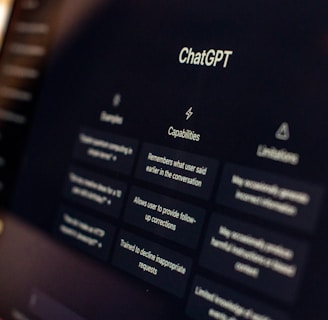5 simple ways to incorporate AI in your daily life
It’s impossible to ignore: artificial intelligence (AI) is everywhere in 2025. From tech launches to social media chatter, AI is the buzzword on everyone’s lips. But what’s all the hype about—and should you care?
TECH ARTICLE
7/21/20254 min read


Is AI the Next Big Thing? Why You Should Start Using It in Your Daily Life Now
Let’s be real—AI isn’t new. It’s been around in various forms for decades. But in the last few years, something has changed. It’s gone from a niche technology only techies talked about to a mainstream tool being baked into the apps, devices, and platforms we use every day.
Whether it’s a startup’s pitch deck, a big-brand keynote, or your smart speaker chirping in the background—AI is being mentioned more than ever before. But is it just another over hyped trend, or could it be the next major turning point in how we live, work, and communicate?
Let’s unpack it.
A Look Back to Look Forward
To understand where AI might be heading, it helps to reflect on how previous tech revolutions evolved. Take the iPhone, for example. When it launched back in 2007, it was sleek and revolutionary—but primitive by today’s standards. Fast forward to 2025, and your iPhone can do everything from paying for groceries to editing 4K video and diagnosing your heart rate.
It didn’t happen overnight, but each year brought updates, new features, and innovations that turned a flashy gadget into a daily necessity. AI is following a similar path—it’s still in its early stages, but the potential is enormous.
So, is AI the next iPhone-level innovation?
Maybe even bigger.
Could AI Be the Next Evolutionary Shift?
In just one generation, we’ve gone from VHS tapes and dial-up internet to streaming content, smartphones, and cloud computing. Each technological leap has changed how we live, work, and interact. AI could be the next jump.
But this time, it’s not just about convenience or speed. It’s about intelligence—your devices, apps, and systems thinking for you, learning from you, and adapting to your life.
We’ve seen a major transformation in how information is shared and consumed in just 20 years. Traditional TV and radio have given way to YouTube, TikTok, podcasts, and real-time newsfeeds. And now, AI is changing how that content is created, tailored, and delivered.
The lines between human and machine are starting to blur, and while that might sound sci-fi, it’s already happening in ways you probably don’t even notice.
So… Why Should You Start Using AI?
It all boils down to three things:
Convenience
Cost-effectiveness
Performance (Is it better than what came before?)
If AI can make your life easier, save you time or money, or deliver a better experience than you’re used to—why wouldn’t you use it?
Here are five easy ways to start incorporating AI into your daily life right now:
1. Use AI-Powered Virtual Assistants
Siri, Google Assistant, Amazon Alexa, and now more recently, Gemini by Google—these virtual assistants have become smarter and more helpful than ever. You can use them to:
Set reminders or alarms
Make calls or send texts
Play your favorite playlist
Answer random questions (“What’s the weather like in Tokyo?”)
Control smart home devices (lights, thermostat, locks, etc.)
They learn from your habits and get better the more you use them. What used to be a novelty (“Hey Siri, tell me a joke”) is now a legit productivity tool.
2. Explore AI Content Creation
Whether you're a small business owner, a student, or someone with a side hustle, AI tools like ChatGPT, Canva’s AI features, or image generators can save hours of work.
Want to create custom and unique music ?
Want to generate captions for Instagram?
Need help scripting a YouTube video?
AI content tools can assist you creatively or help you brainstorm when you’re stuck. They’re not replacing creativity—they’re enhancing it.
3. Simplify Your Finances with AI
Managing money doesn’t have to be a headache. In 2025, there are plenty of AI-powered tools that help you track your budget, monitor spending, and even make smarter financial decisions.
Apps like Cleo, YNAB (You Need a Budget), or even integrated tools within banking apps can:
Categorize your spending
Identify patterns or bad habits
Suggest budget tweaks
Send alerts when you’re about to overspend
Think of it like having a personal finance coach in your pocket.
4. Improve Your Health & Wellbeing
AI has made its way into fitness trackers, mental health apps, and even meal planning. Devices like the Apple Watch, Fitbit, and Oura Ring now use AI to analyze your sleep patterns, stress levels, and heart rate, offering insights that help you optimise your health.
AI wellness apps can:
Personalize workout routines
Offer breathing and meditation prompts
Suggest better sleep schedules
Track your water intake or meal quality
And it’s not just fitness—AI chat bots and platforms are also being used in therapy support, mental health check-ins, and habit tracking.
5. Build a Smarter Home
Everything is becoming “smart”—from your fridge to your front door.
In 2025, AI integration in smart home devices means more than just turning on lights with your voice. It means:
Your thermostat learning your preferences
Your vacuum cleaning when you're out
Your fridge suggesting recipes based on what’s inside
Security systems detecting unusual activity and alerting you
As more devices become interconnected, AI acts as the central brain, helping your home work for you, not the other way around.
Final Thoughts: Start Small, Stay Curious
AI isn’t just for techies anymore. It’s becoming part of the digital fabric we all interact with. And while we’re still early in its evolution, waiting too long to get comfortable with it might mean missing out on a powerful tool that can genuinely enhance your life.
Just like the internet, smartphones, and apps changed our world, AI is poised to do the same—if not more.
So don’t be afraid to start exploring. Try out that new feature on your phone. Ask your virtual assistant something new. Play with an AI image generator. Automate your to-do list.
The AI future isn’t coming.
It’s already here.
And it’s time to make it work for you.
Finance & Tech Blog
Simplifying finance and tech for everyone’s understanding.
Contact Info
register below for email updates
© 2025. All rights reserved.


